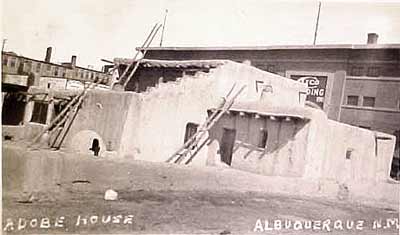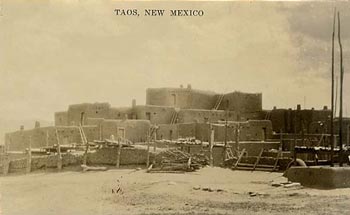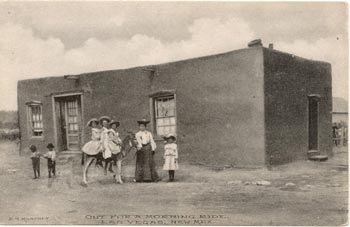Alistair Knox was the father of the modern mudbrick and owner building movements in Australia.
Occupation

Throngs of anglo visitors overtake the Native American village of Taos Pueblo. One can only speculate the outcome of a reversed scenario.
Historic Albuquerque

Adobe house in Albuquerque, circa 1926.
San Felipe Pueblo

This postcard is captioned PUEBLO OF SAN FELIPE, NEW MEXICO. The back reads, The Pueblo lies on the east bank of the Rio Grande, about three miles from Bernalillo, and may be seen from the car windows en route to Albuquerque. The population is about 600. The church is one of the sights of the pueblo, having two towers and a large yard, the whole being enclosed with a high arched adobe wall. there is also the ever present Estufa or sacred meeting place where the chiefs congregate at times. The pueblo Indian while maintaining the mission churches still preserves many of the tribal customs. Circa 1915-1929
Ziggurat at Ur
One of the most intriguing monuments still standing in Iraq is the Ziggurat at Ur. A ziggurat is a colossal stepped platform; and it is thought that ziggurats supported temples at their tops. These ziggurats were built during the third millennium B.C. Archaeologists don’t know for certain what the purpose of these ziggurats was; however, it is speculated that they had some connection with religion. There are several ziggurats visible throughout Iraq, the most famous of which is the ziggurat at Ur in the south of Iraq. The core of the ziggurat at Ur was constructed using mud bricks which were then covered with baked bricks. The mud bricks were made out of mud and reed; the reed was pressed into moulds that had been left to dry in the sun. Each brick measured around 25 x 16 x 7 centimeters and weighed around 4.5 kilograms.
Ctesiphon Arch

The Ctesiphon arch is considered as one of the many architectural wonders of Mesopotamia. This arch was built in 400 A.D. by the Parthian Persians to be the largest single-span vault of un-reinforced brickwork in the world. The arch has a span of seventy-five feet and is about 110 feet high.It stands in the ancient city of Ctesiphon. Ctesiphon is a historically significant city that lies on the east bank of the Tigris River just south of Baghdad. The Ctesiphon arch is a pointed ovoid peculiar to Mesopotamian architecture; it was built using unfired, thin mud bricks which were laid on a slant.
Afghanistan Unreconstructed

Image from (Afghanistan) Unreconstructed, New York Times Magazine, Sunday 06/01/03
ADOBE CONFERENCE MAY 16 AND 17
The Adobe Association of the Southwest
Northern New Mexico Community College
El Rito Campus in its wonderful old adobe buildings
Friday 16th Dinner/ Reunion and Plenary Session/Keynote Presentations/Dedications
Saturday 17th Presentations/Poster Sessions/Meals Continue reading “ADOBE CONFERENCE MAY 16 AND 17”
Taos

Taos Pueblo. Date unknown
Las Vegas

Out for a Ride. Las Vegas, New Mexico. Circa 1910.
